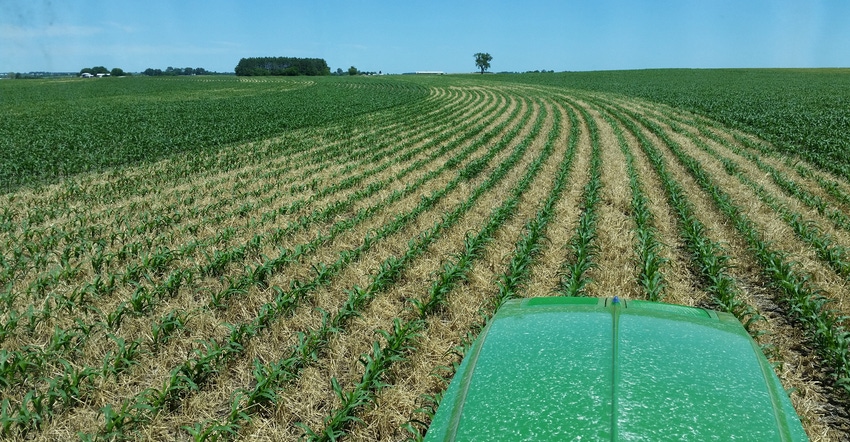December 28, 2017

By Nick Ohde
Growing a cereal rye cover crop in a field over winter before planting the field to soybeans in spring has become standard practice for more farmers across Iowa.
Get the rye established in the fall before corn harvest via aerial or highboy seeding, or after harvest with a drill. Or some use an air seeder or fertilizer spreader to seed the cover crop. In the spring, let the rye grow right up until soybean planting (or even after) and then kill the rye.
Practical Farmers of Iowa and Iowa Learning Farms research has shown that having a rye cover crop before beans doesn’t cause yield drag, and in many cases, you might see a yield increase for soybeans. It’s a no-brainer for protecting the soil and water and maybe saving some money on weed management. At the very least, according to research by Iowa State University economist Alejandro Plastina, cereal rye before soybeans has a breakeven return on investment, mainly due to savings on herbicide applications.
But corn is a different story. Research and farmer experience have shown that delaying cover crop termination until near corn planting can result in yield reductions. Many people attribute this to “allelopathy” — rye’s ability to exude biochemicals that inhibit other plants from growing nearby. However, research shows that this is likely not the mechanism for yield reduction. Rather, it seems more likely that the recently terminated rye immobilizes nitrogen in the soil precisely at the time the emerging corn seedling needs nitrogen to be available for uptake.
Farmers are using several N fertilizer strategies for corn following a cover crop. Because yield reductions in corn are likely related to nitrogen dynamics, many experienced farmers terminate cover crops two to three weeks prior to planting corn, to allow the rye time to decompose.
Getting maximum benefits
Cover crop farmers like the cover to get more growth. “I want to achieve maximum growth and benefits from my cover crop without limiting corn yield,” says Dick Sloan of Rowley in northeast Iowa. In 2016, he planted corn into a cereal rye cover crop that was terminated just two days before corn planting. He saw a 5-bushel-per-acre yield reduction compared to where he terminated the cover crop two weeks prior to planting corn, yet stands were equal between the two treatments.
In 2017, Sloan and fellow farmer-researcher Tim Sieren of Keota in southeast Iowa conducted trials with PFI to investigate the interaction between nitrogen management, cover crops and corn yield. Sieren presented his portion of the research trial at PFI’s Cooperators’ Meeting in December in Ames. “The practice of using cover crops is now at the place no-till was 30 years ago,” he says. “A lot of my neighbors are doing it. I get questions from farmers. Some have successes and some have failures, and I want to get as much info as I can so I can make it work.”
Sloan compared low and high N rates in both of his fields, while Sieren assessed N application timing and form.
Sieren applied 140 pounds of N per acre to all treatments but varied the timing of application and the form of N applied. Regardless of strategy, he scored top returns when he terminated the cover crop 19 days before planting. He saw the best returns when the cover crops were terminated 19 days before planting and yields were also greatest. Nitrogen costs were greatest and returns on investment were least when the cover crops were terminated one day before planting.
But across both farms, terminating the cover crop near the time of corn planting (either three days or one day before planting) often resulted in a yield reduction compared to when the cover crop was terminated about three weeks prior to corn planting (21 or 19 days before planting). Higher N rates or varying the N strategy at the farms did not appear to overcome the yield-reducing effects of terminating the cover crop near corn planting.
The exception came where Sloan followed corn with corn and applied fall hog manure in addition to applying N fertilizer at corn planting and sidedress. In this instance, terminating the cover three days before planting corn resulted in no yield drag compared to when he terminated the cover crop 19 days before planting.
The cover crop in the corn-following-corn field at Sloan’s was comprised of winter wheat, oats, winter barley and rapeseed. The lack of cereal rye in that mix may have contributed to the smaller amount of biomass produced than in the corn-following-soybean field where the cover was winter wheat, winter barley and cereal rye.
In turn, this may have led to less early-season N stress on the corn. Thus, the cover crop in the mix or the amount of cover crop growth could be a factor when terminating a cover crop before planting corn. “It’s not the cover crop termination date, it’s the amount of biomass produced,” Sloan says. “When I have good cover crop growth, I will kill it early and plant corn early, a few days after termination, to get my corn planted earlier.”
For the full report, read N Fertilizer Strategies for Corn Following Cover Crop.
Ohde writes for PFI at Ames.
You May Also Like




